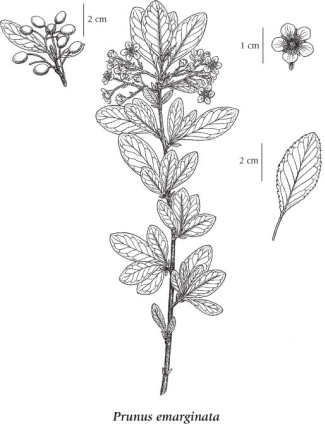Prunus emarginata (Douglas ex Hook.) D. Dietr.
bitter cherry
Rosaceae (Rose family)
Introduction to Vascular Plants
bitter cherry
Rosaceae (Rose family)
Introduction to Vascular Plants
Introduction
This small deciduous species of cherry tree is native to British Columbia. It is found from BC south to California and east to Montana, Wyoming and Arizona.
|
Species Information
General:
Shrub or small tree, 2-15 m tall, sometimes thicket-forming, smooth to densely hairy throughout; bark reddish-brown or grey, with horizontal lenticels.
Leaves:
Alternate, deciduous, elliptic to egg-shaped or lanceolate, 3-8 cm long, finely round-toothed, rounded or blunt to sometimes sharp-pointed at the tip, wedge-shaped to pointed at the base, densely hairy (at least below) to smooth; leaf stalks 5-12 mm long, usually lacking small glands at the top.
Flowers:
Inflorescences short, rounded to flat-topped clusters, at the ends of short spur-shoots, of 3 to 10 stalked flowers; corollas white, saucer-shaped, the petals 5, egg-shaped, 5-7 mm long, often hairy on the lower surface; calyces smooth to coarse-hairy, 5-lobed, the oblong lobes about 2 mm long; ovaries superior; stamens about 20.
Fruits:
Fleshy drupes with a large ellipsoid stone (cherries), egg- to globe-shaped, 8-12 mm long, bright red to purple; seeds 1.
Notes:
The more typical tree-like plants from coastal areas have been given the varietal name mollis (Dougl.) Brew.
Illustration

If more than one illustration is available for a species (e.g., separate illustrations were provided for two subspecies) then links to the separate images will be provided below. Note that individual subspecies or varietal illustrations are not always available.
Illustration Source: The Illustrated Flora of British Columbia
USDA Species Characteristics
Flower Colour:
White
Blooming Period:
Mid Spring
Fruit/Seed characteristics:
Colour: Red
Present from Summer to Fall
Source: The USDA
Ecology
Ecological Framework for Prunus emarginata
The table below shows the species-specific information calculated from
original data (BEC database) provided by the BC Ministry of Forests and Range.
(Updated August, 2013)
The table below shows the species-specific information calculated from
original data (BEC database) provided by the BC Ministry of Forests and Range.
(Updated August, 2013)
| Site Information |
Value / Class |
||
|
Avg |
Min |
Max |
|
| Elevation
(metres) |
535 | 10 | 1609 |
| Slope
Gradient (%) |
24 | 0 | 90 |
|
Aspect (degrees) |
193 | 0 | 360 |
| Soil
Moisture Regime (SMR) [0 - very xeric; 4 - mesic; 8 - hydric] |
3 | 0 | 7 |
| Modal
Nutrient Regime
Class |
C | ||
| #
of field plots species was recorded in: |
299 | ||
| Modal
BEC Zone Class |
CWH | ||
|
All BEC Zones (# of stations/zone) species was recorded in |
BG(1), BWBS(3), CDF(13), CWH(122), ESSF(2), ICH(40), IDF(46), MS(3), PP(11), SBS(2) | ||
|
Source:
Klinkenberg 2013
|
|||